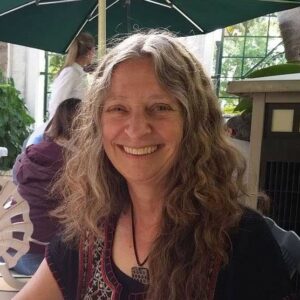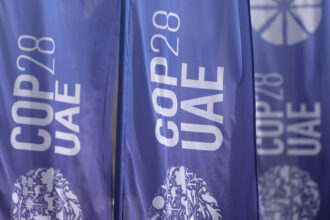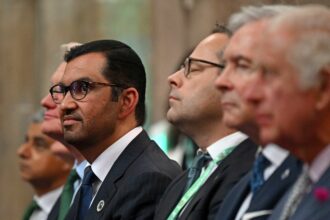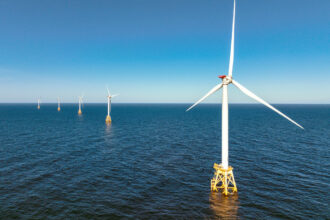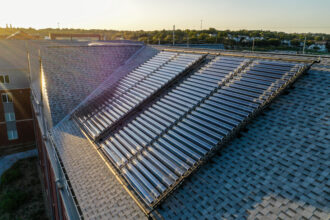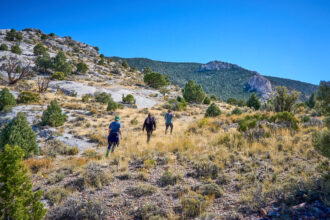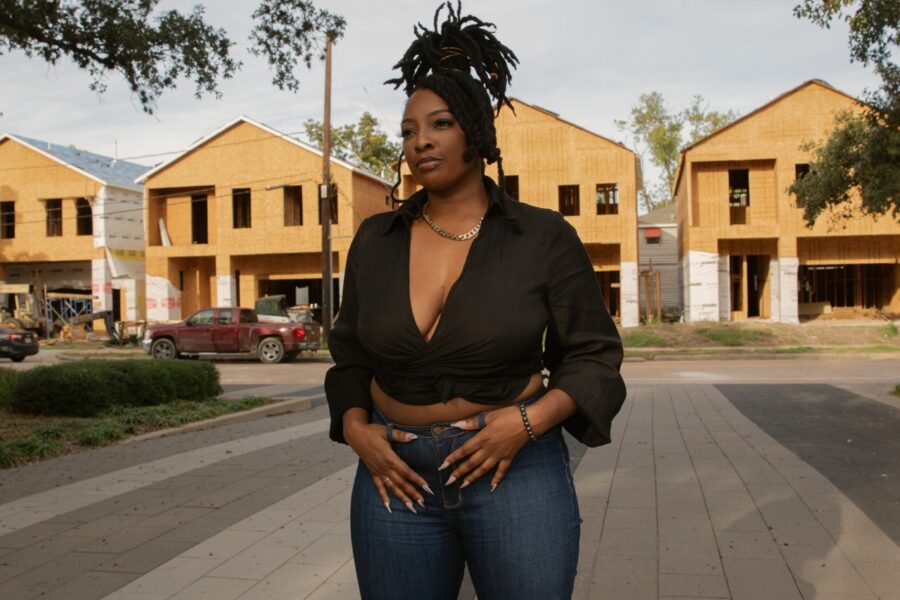As world leaders gather in Dubai for the 28th United Nations climate talks, Indigenous representatives from seven socio-cultural regions are calling for a moratorium on “false solutions” that ignore the roots of the climate crisis and urging a drastic reduction of greenhouse gas emissions.
The Indigenous peoples’ caucus, called the International Indigenous Peoples’ Forum on Climate Change, or IIPFCC, had two minutes during COP28’s opening plenary Thursday to lay out their core concerns and assert their “inherent, distinct, internationally recognized rights” to influence the negotiations.
They called for creation of a mechanism for presenting grievances when carbon trading and offset schemes might impact the rights and lands of Indigenous peoples, strategies that prioritize the prevention of catastrophic loss and damage from climate change, direct access to funds when damage occurs, the equitable phaseout of fossil fuels and a just transition that respects Indigenous rights and knowledge.
The parties to the 2015 Paris Agreement said limiting global warming to 1.5 degrees Celsius over preindustrial levels must be the main objective of that accord, said Andrea Carmen, a coauthor of the IIPFCC’s statement, member of the Yaqui Nation and executive director of the International Indian Treaty Council.
“The scientists, the scientific bodies as well as Indigenous peoples have all said that any more than that, there’d be major impacts to the ways of life and even the lands of Indigenous people,” she said.
Yet Indigenous people are facing increasing disasters in their homelands because states have failed in their commitment to limit temperature rise, said Pema Wangmo Lama, an Indigenous youth activist from the Mugum Indigenous community in Nepal, in IIPFCC’s Asia region, in the caucus’ opening statement Thursday. In 2023, which is on track to be the warmest year on record, “this global cap was exceeded, threatening our ways of life in Asia and around the world,” Pema said.
“We’re already seeing disasters impact Indigenous peoples’ homelands in greater and greater numbers, whether it’s fires, hurricanes, flooding or seeing many, many species that we depend on, including California salmon, on the endangered and threatened list because of the impacts of even small degrees of warming of water bodies,” said Carmen, one of two members from the IIPFCC’s North America region and former co-chair of the Local Communities and Indigenous Peoples Platform’s Facilitative Working Group, or FWG, which was established at COP24 to strengthen and exchange traditional knowledge.
Real solutions require drastic reduction of greenhouse gas emissions based on the equitable phaseout of fossil fuels, the IIPFCC statement argued.
Indigenous peoples here are demanding the parties to this conference recommit to the 1.5 degree target, said Tom Goldtooth, executive director of the Indigenous Environmental Network, at a press conference in Dubai Thursday. “We all stand united in collective decision demanding a phaseout of fossil fuels.”
Indigenous peoples have worked as an organized constituency at the U.N. since 1977 and have long united around common threads, Carmen said.
The fact that more than 300 Indigenous delegates “from literally every region of the world” could agree on what to say in a two-minute statement is a testimony to how Indigenous people can come together with one mind and one spirit, she said.
“Our ecosystems, our food systems, our ways of life, our knowledge systems, all of these are really on the line here,” Carmen said. That’s why, she added, “We started our statement saying this is a matter of life and death for us.”
Colonial Déjà Vu
Indigenous peoples’ intimate relationship to their environment and reliance on local ecosystems leaves them disproportionately affected by the consequences of a rapidly warming world.
They face these heightened risks largely due to the ways colonial laws and policies, combined with capitalist economics, opened up Indigenous territories for carbon-intensive development, argues Kyle Whyte, an author of the Fifth U.S. National Climate Assessment who serves on the White House Environmental Justice Advisory Council, in an essay about Indigenous peoples and climate injustice.
Whyte describes a colonial déjà vu with climate change echoing the same types of drastic environmental changes tribes and First Nations experienced during first contact with Europeans.
“Climate change is a manifestation of the colonial project,” said Graeme Reed, a North America representative of the FWG who works at the Assembly of First Nations. “And that colonial project is built on the removal of Indigenous peoples from their lands, waters and territories, and the blatant disrespect of their rights, their knowledge systems and their governance.”
That’s why, said Reed, who is of mixed Anishinaabe and European descent, “when we’re talking about what we need to do to advance rapid decarbonisation, that needs to correspond with decolonization.”
And for Reed, that means finding meaningful ways to address the root causes of both.
That’s not what’s happening in Canada, he said, where there’s a lack of accounting within Scope 3 emissions, those produced throughout a company’s supply chain or through use of its goods. Canada is projected to produce more oil and gas in 2050 than now, Reed said. But since most of that oil and gas will be exported, it doesn’t get counted on Canada’s carbon balance sheet.
The notion that you’re not accountable for the burning of the natural resources you develop is “a really Western way of looking at the problem,” Reed said. “I would characterize that as creative accounting, settler accounting.”
It takes years to effect changes within global climate talks, Reed said. “Then I see how fast climate change is impacting our lands, waters and territories, and it terrifies me that we are not creating a system of governance that actually addresses the root cause of these issues.”
Indigenous people show up within these spaces, “because we have solutions,” he said. “But we also recognize that these spaces are also dominated by people who want to uphold the status quo.”
Prioritizing Prevention and Fighting “False Solutions”
On Thursday, world leaders greenlit the creation of a “loss and damage” fund to help developing countries cope with increasingly devastating climate impacts. It’s another issue at the top of IIPFCC’s agenda.
“We’re challenging the concept that bad things have to happen, that species have to disappear, people’s homeland has to be severely degraded, before there’s a recognition that there’s been damage,” said Carmen, of the International Indian Treaty Council. “Because for Indigenous peoples, many of these losses and damages are not reparable.”
Indigenous peoples from all regions must be able to directly access funds and influence how decisions are made, Carmen said. But more important, in some ways, is the need to focus on preventing loss and damage in the first place, she said. “And the only way to do that is to keep that temperature rise down and to have what’s being termed ‘a phase out of fossil fuel use.’”
For many Indigenous peoples, global and national approaches to climate policy reveal a fundamental disconnect between different ways of knowing and being.
One consequence of that disconnect is that Western governments lack effective mechanisms for assessing how extractive development affects Indigenous people’s spiritual and cultural relationship to the environment. That issue was central to Indigenous concerns when an energy company proposed routing the Dakota Access Pipeline through the Missouri River, north of the Standing Rock Sioux Reservation.
“That was viewed primarily as a violation of our spiritual relationship and protection of Mother Earth and the spirituality of water,” said Goldtooth, who is Dine’ and Dakota, in an interview. What’s more, crude oil pipeline builders couldn’t guarantee that they wouldn’t disturb burial or cultural sites.
The government never adequately supported the Standing Rock Sioux Tribe to inventory those sites, Goldtooth said. “But it was quick to make a decision to put the pipeline in the ground.”
Goldtooth, who has participated in the U.N. Framework Convention on Climate Change since 1998, said he was surprised when Indigenous people’s calls for moving toward reductions in those early days were met instead with calls to focus on forests as carbon sinks, “what we termed false solutions.”
The fundamental idea of carbon markets, which quantify carbon sequestered in forests, peatlands and other ecosystems as a way to reduce emissions by issuing credits for sale, is antithetical to Indigenous worldviews.
The notion of commodifying carbon confuses and angers spiritual leaders, he said. They see the notion of bringing air, and the elements of air, into a market system as an affront to the natural laws that Indigenous people have a responsibility to uphold.
“These are things when I talk to spiritual elders, it confuses them, this world that is manipulating the natural laws and the sacredness of Mother Earth and Father Sky,” said Goldtooth. “They get upset and say, ‘What right do they have playing God to control everything that we have valued for the biodiversity, the circle of life itself.’”
His organization, Indigenous Environmental Network, responded with a campaign to keep fossil fuels in the ground.
A major focus on the IIPFCC is around Article 6 of the Paris Agreement, the rulebook governing carbon markets, which Indigenous leaders aim to influence over the next two weeks.
“Carbon markets and offsets, geoengineering, maladaptation technologies, net zero frameworks and nature-based solutions do not cut emissions and instead create new forms of colonization, militarization, criminalization and land loss,” said Pema, in the IIPFCC’s opening statement. “We call for a moratorium on such activities that violate our rights.”
Goldtooth believes carbon markets and associated technologies like direct air capture are being used by the fossil fuel industry to justify more extraction. He sees no clear methodology within human rights agreements that would protect Indigenous peoples from land grabs happening around these market systems. He and other leaders will be fighting for language that provides for appeal and grievance mechanisms for carbon trading programs that impact Indigenous lands.
They’re also pushing for an early warning component, so when mitigation measures like lithium mining, large-scale wind farms or dams are proposed as low-carbon solutions, Indigenous people can determine whether potential impacts on their lands are addressed.
When Indigenous peoples challenge things like industrial wind farms, Carmen said, “it’s not because we don’t agree with alternative energy but because our rights and cultures and sacred areas need to be considered.”
The Paris Agreement says that states will uphold their obligations to the rights of Indigenous people in all climate actions, Carmen said. “They agreed to it. Why do we keep having to bring it up?”
Whose Definition of Nature?
Many international mechanisms describe the root cause of the climate crisis as the release of greenhouse gas emissions and focus on quantifying temperature goals, Reed said. “Lots of indigenous folks would say that emissions are a manifestation of a deeper problem. And that deeper problem originates in a disconnection between humans and the natural world.”
A perceived separation of humans and nature lies at the center of mainstream Western thought, which operates through frameworks of domination and a belief in human supremacy, said Reed. “That manifests very deeply within spaces like COP, where solutions called nature-based solutions are growing in presence and attention.”
But your understanding of whether you’re a part of or separate from nature greatly influences the types of solutions you propose. If you see yourself as part of the natural world, all solutions are nature based, he said. “If you believe you’re separate, then you create solutions that continue to uphold that kind of dichotomization.”
Some non-governmental organizations at COP28 are pushing for a redoubling of efforts to transition away from fossil fuels while boosting investments in locally led natured-based solutions to reduce emissions.
“Nature is central to our collective humanity, our various cultures, identity and futures as human beings,” said Sushil Raj, executive director of rights and communities for the Wildlife Conservation Society, in a press briefing last month. “Indigenous peoples and traditional communities reflect this most clearly through their ways of life, knowledge and belief systems.”
Eighty percent of Earth’s biodiversity lies within Indigenous lands, including roughly a third of intact forests. Yet Indigenous people and local communities receive less than 1 percent of global funding for climate and biodiversity and lack direct access to this funding. States must make significant investments in nature and “high-integrity ecosystems” with Indigenous peoples and local communities taking an active part in crafting solutions, Raj said, “as they are the best guardians of nature.”
Raj and his colleagues will be advocating that COP28 negotiators fully integrate the principles of self-determination and “free, prior and informed consent” outlined in the U.N. Declaration on the Rights of Indigenous Peoples.
Too often, Indigenous peoples are not only left out of such discussions but are displaced in the name of forest conservation schemes, said Cristina Coc, a Q’eqchi Mayan community leader in Southern Belize and global advocacy coordinator for Indigenous Peoples Rights International. Hundreds of Ogiek people were forcibly removed from their homelands in Kenya’s Mau Forest, which Coc and other human rights observers say is linked to carbon trading.
This story is funded by readers like you.
Our nonprofit newsroom provides award-winning climate coverage free of charge and advertising. We rely on donations from readers like you to keep going. Please donate now to support our work.
Donate NowCoc has been fighting what she calls a similar assault on Indigenous people’s lands at home, where she said Flora and Fauna International bought more than 11,000 acres of Mayan forestland without their consent. Flora and Fauna International told the Guardian it bought the land from private owners and would conserve and protect the area’s wildlife while supporting the livelihoods and traditional rights of local people.
“Indigenous peoples have a proven track record of maintaining the integrity of our forests and lands,” said Coc. “Unless and until we are part of deciding what the solutions are going to be, we are going to see the end of humanity in a very, very destructive way.”
Ultimately, Carmen said, states aren’t doing “anywhere near enough” to confront the climate crisis. She thinks everyone on every level, Indigenous or not, must do more and think about what they’re leaving for their children and grandchildren or their great nieces and grandnephews.
Everyone needs to consider how future generations will look back on what we do today, Carmen said. “Are we doing enough? Can we do more? I think we can.”






